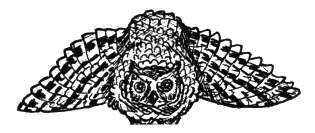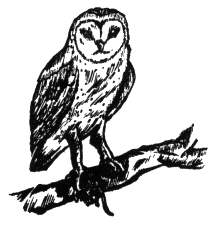Owl
 You'll never mistake an owl for another kind of bird! They are the only birds with flat faces and both eyes in front. Unlike other birds, they can watch an object with both eyes at the same time, but they cannot look sideways without turning their heads.
If you walk around and around an owl he will seem to keep turning his head in the same direction to watch you. Some people have thought that they could get an owl to twist his head off this way. But he turns his head almost halfway around and then turns it back the other way so quickly that you can't see him do it.
You'll never mistake an owl for another kind of bird! They are the only birds with flat faces and both eyes in front. Unlike other birds, they can watch an object with both eyes at the same time, but they cannot look sideways without turning their heads.
If you walk around and around an owl he will seem to keep turning his head in the same direction to watch you. Some people have thought that they could get an owl to twist his head off this way. But he turns his head almost halfway around and then turns it back the other way so quickly that you can't see him do it.
Owls have eyesight a hundred times as good as ours. At least one kind of owl can see to catch its prey when the light is no more than that of an ordinary candle shining almost half a mile away.
Most birds close their eyes by raising the lower eyelid but the owl lowers the upper eyelid as we do. Owls also have eyelashes.
Owls' ears are special too. They are simply holes in the side of the head, protected by a flap of skin and hidden by the feathers. When we hear a sound we do not know exactly where it comes from. But an owl knows! One of the owls' ear openings points upward and the other downward. In at least one kind of owl the skull bones are different on the two sides of the head. This enables the owl to pinpoint the direction of a sound. The owl's face has a ring of stiff curved feathers around it from which the sound waves bounce into the ear drums.
To test its hearing, a pet owl was put in a pitch-black room with dry leaves on the floor. A mouse was turned loose, and in a few seconds the owl swooped down and then flew back to its perch. The lights were turned on, showing the owl with the mouse. Out of 11 tests the owl missed only 4 times, and then it came close. Someone wondered if the bird could smell the mouse or feel heat from it. But when wads of paper were pulled across the floor the owl caught them too.
There are many kinds of owls and they come in different sizes. The biggest is the great horned owl, which is two feet tall. (It doesn't really have horns, but just tufts of feathers that stand up at the corners of its head like ears. But they don't have anything to do with hearing either.)

Fascinating Facts About Birds
by Mina Arnold Young
|
The smallest is the elf owl, which is only as big as a sparrow.
Besides special eyes and ears, owls have special feathers. The flight feathers are soft and fluffy and have fuzzy edges, so there is no swishing sound when the bird flies through the air. Most of the little creatures the owl catches have no idea that danger is near.
Owls also have special feet. When they touch the prey the toes clinch automatically. The outer toe may be turned backward to help in perching, or forward or sideways to help in grasping prey. Not every bird can boast of a swivel toe! Some fish owls of Africa and Asia have horny spikes on their feet to help them hold slippery fish. The snowy owl, also called the great owl, has feathers on its feet all the way down to its claws. These not only protect its feet from the cold of the ice and snow in the frozen North, but act like snowshoes to keep it from sinking in soft snow.
Owls usually live alone, except during the nesting season. Most of them hunt at night and hide and sleep during the day. All of them swallow their food whole, if it is small enough. If not, they tear it up and swallow the pieces. Inside the owl, the meat is separated from the bones, hair and so forth. The waste material is then rolled up into little pellets, which the owl spits out. It's a very neat arrangement, but how does he do it? Don't ask the owl. He doesn't know either!
Some owls live in rather small areas. The little elf owl lives only on the western deserts where the tall saguaro cactus grows. He lives in a hole that a Gila woodpecker dug out of the cactus. During the nesting season the temperature on the desert may reach 120 degrees. But the elf owl family has a nice insulated home inside the cactus.
 The barn owl is the least like other owls. It is sometimes called the monkey-faced owl because of its heart-shaped face. These owl are 16 to 18 inches long, with the female larger than the male. It has a strange habit of lowering its head and moving it back and forth. It nests in hollow trees, old barns and other abandoned buildings, or even in a hole in a high creek bank.
The barn owl is the least like other owls. It is sometimes called the monkey-faced owl because of its heart-shaped face. These owl are 16 to 18 inches long, with the female larger than the male. It has a strange habit of lowering its head and moving it back and forth. It nests in hollow trees, old barns and other abandoned buildings, or even in a hole in a high creek bank.
More Owls
|
Index
|
Home
 You'll never mistake an owl for another kind of bird! They are the only birds with flat faces and both eyes in front. Unlike other birds, they can watch an object with both eyes at the same time, but they cannot look sideways without turning their heads.
If you walk around and around an owl he will seem to keep turning his head in the same direction to watch you. Some people have thought that they could get an owl to twist his head off this way. But he turns his head almost halfway around and then turns it back the other way so quickly that you can't see him do it.
You'll never mistake an owl for another kind of bird! They are the only birds with flat faces and both eyes in front. Unlike other birds, they can watch an object with both eyes at the same time, but they cannot look sideways without turning their heads.
If you walk around and around an owl he will seem to keep turning his head in the same direction to watch you. Some people have thought that they could get an owl to twist his head off this way. But he turns his head almost halfway around and then turns it back the other way so quickly that you can't see him do it.
 The barn owl is the least like other owls. It is sometimes called the monkey-faced owl because of its heart-shaped face. These owl are 16 to 18 inches long, with the female larger than the male. It has a strange habit of lowering its head and moving it back and forth. It nests in hollow trees, old barns and other abandoned buildings, or even in a hole in a high creek bank.
The barn owl is the least like other owls. It is sometimes called the monkey-faced owl because of its heart-shaped face. These owl are 16 to 18 inches long, with the female larger than the male. It has a strange habit of lowering its head and moving it back and forth. It nests in hollow trees, old barns and other abandoned buildings, or even in a hole in a high creek bank.